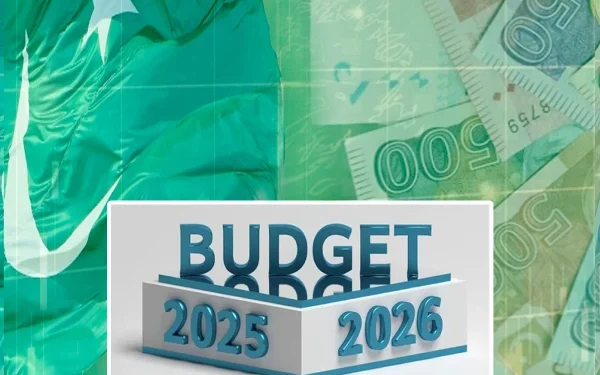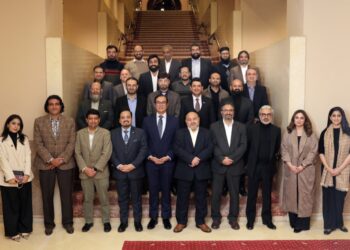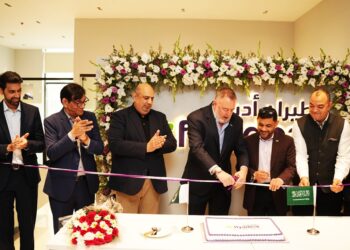Islamabad, The Annual Plan Coordination Committee (APCC) has approved Pakistan’s federal development budget for the fiscal year 2025-26, setting it at Rs 1,000 billion. Alongside this, the government has established an economic growth target of 4.2%, reflecting an ambitious agenda for national development despite financial constraints and external pressures.
Overview of National Development Budget
The APCC, chaired by Federal Minister for Planning Ahsan Iqbal, sanctioned a total national development outlay of Rs 4.1 trillion. Out of this, Rs 2.8 trillion will be sourced from the four provinces, while the federal government’s share stands at Rs 1 trillion. The development budget will now move to the National Economic Council (NEC), chaired by the Prime Minister, for final approval before its inclusion in the federal budget presentation to Parliament.
Provincial Allocations and Spending
Provinces will significantly increase their developmental spending compared to the current fiscal year:
- Punjab will lead with an allocation of Rs 1.19 trillion, reflecting a 41% increase.
- Sindh will invest Rs 887 billion, marking a 7% rise.
- Khyber Pakhtunkhwa (KP) will allocate Rs 440 billion, a substantial 63% increase.
- Balochistan plans to spend Rs 280 billion, up by Rs 32 billion.
The federal government will also borrow Rs 270 billion for its development projects, and the provinces are expected to raise Rs 802 billion through foreign loans.
Development Priorities Amid Resource Constraints
Despite a severe resource crunch, several priority areas have been identified. A significant concern is the proposed 45% cut in the water sector budget—from Rs 259 billion to Rs 140 billion—even amid threats from India to reduce Pakistan’s water share. Nevertheless, the government remains committed to accelerating the construction of the Diamer-Bhasha Dam and other strategic water and infrastructure projects.
Among the flagship initiatives for the fiscal year:
- Rs 120 billion allocated for the Quetta-Chaman-Karachi (N-25) Expressway
- Funds earmarked for the Diamer-Bhasha Dam
- Prioritization of the Karakoram Highway Phase II and Hyderabad-Sukkur Motorway
However, critics argue that the remaining Rs 880 billion will be insufficient for the multitude of development demands.
Sector-Wise Budget Distribution
The following are the notable allocations:
- National Highway Authority (NHA): Rs 228 billion
- Power Division: Rs 104 billion (a 41% decrease)
- Water Resources Division: Rs 140 billion
- Suparco: Rs 24 billion
- Cabinet Division: Rs 50.33 billion
- Provincial and Special Area Development: Rs 245 billion
- Merged Districts: Rs 70 billion
- Azad Jammu & Kashmir and Gilgit-Baltistan: Rs 82 billion
In the social sector:
- Federal Education and Professional Training: Rs 19 billion
- Defense Division: Rs 11 billion
- Higher Education Commission (HEC): Rs 42 billion (down 32%)
- Railways: Rs 24 billion
- National Health: Rs 12 billion
- Interior Ministry: Rs 10.9 billion
- Information Ministry: Rs 4.33 billion
Macroeconomic Targets for 2025-26
The government has set various macroeconomic goals to stimulate economic revival:
- GDP growth target: 4.2%
- Inflation target: 7.5%
- Agricultural growth target: 4.5%
- Major crops (wheat, rice): 6.7%
- Cotton ginning: 7%
- Livestock: 4.2%
- Industrial sector growth: 4.4%
- Large-scale manufacturing: 3.5%
- Mining: 3%
- Utilities (electricity, gas, water): 3.5%
- Construction sector growth: 3.8%
- Services sector growth: 4%
Other economic indicators:
- National savings target: 14.3% of GDP
- Investment-to-GDP ratio: 14.7%
- Current account deficit: 0.4% of GDP
- Public investment: 3.2% of GDP
- Private investment: 9.8% of GDP
Austerity Measures and Policy Shifts
A major policy shift includes halting new provincial-level projects under the federal PSDP. Federal Minister Ahsan Iqbal emphasized that due to budget constraints and the need to honor commitments with the IMF, even projects under Rs 1 billion won’t be approved until the IMF program concludes.
More than 118 low-priority or stalled projects have already been discontinued. The Ministry of Planning has identified 183 delayed projects recommended for cancellation or resizing by June 2025.
Despite these cutbacks, Rs 50 billion has been reserved for the Sustainable Development Goals (SDG) program—used for parliamentarians’ development schemes.
Political Dynamics and Budget Controversies
Budget allocations have not been free from political wrangling. Sindh, led by the Pakistan Peoples Party (PPP), has secured Rs 86 billion from the federal PSDP. Critics claim this was politically motivated due to PPP’s alliance with the ruling coalition.
Khyber Pakhtunkhwa Finance Advisor Muzammil Aslam voiced concerns over KP receiving just Rs 3 billion, while Sindh got Rs 47 billion. Punjab’s federal share was only Rs 15 billion. However, Ahsan Iqbal clarified that Rs 70 billion allocated for merged districts—formerly part of FATA—also benefits KP.
Challenges and Strategic Directions
Minister Ahsan Iqbal underscored the need for strategic resource allocation, stating, “Half of our expenses are going to repay loans. The development budget has been shrinking for years. We must enhance national revenue and enforce policy continuity to ensure sustainable growth.”
He also pointed out that Pakistan remains one of the lowest tax-collecting nations globally. The government is intensifying efforts to curb tax evasion, promote agriculture, and encourage SMEs.
Iqbal urged provinces to take charge of their own development schemes post-18th Amendment. “The federation cannot continue funding provincial projects while neglecting vital national initiatives,” he added.
Conclusion: Balancing Growth with Fiscal Prudence
The Rs 1,000 billion federal development budget, while lower than last year’s allocation, demonstrates the government’s intent to balance fiscal responsibility with economic revival. With ambitious growth targets and tighter controls on expenditures, the 2025-26 development plan seeks to steer Pakistan through economic headwinds.
Yet, the efficacy of this plan will depend on prudent execution, provincial cooperation, and international financial support. As the federal PSDP awaits final approval by the NEC and Parliament, the coming weeks will reveal the political and economic resolve behind these numbers.

























